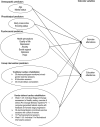Predicting cardiac rehabilitation attendance in a gender-tailored randomized clinical trial
- PMID: 20216324
- PMCID: PMC2913420
- DOI: 10.1097/HCR.0b013e3181d0c2ce
Predicting cardiac rehabilitation attendance in a gender-tailored randomized clinical trial
Abstract
Purpose: This study compared attendance of women participating in a motivationally enhanced, gender-tailored cardiac rehabilitation (CR) program with that of women attending a traditional outpatient CR program. We also sought to determine the significant baseline predictors of attendance of the exercise and education components of the interventions.
Methods: Data from 252 women with CHD in the randomized clinical trial, the Women's-Only Cardiac Rehabilitation Program, were used in this study. The experimental design used 2 treatment groups: both receiving a comprehensive, 12-week, CR program, with 1 group receiving a gender-tailored, stage-of-change matched, behavioral enhancement using individualized motivational interviewing.
Results: Compared with women in the traditional CR program, women in the gender-tailored program attended significantly more of the prescribed exercise (90% vs 77%) and education sessions (87% vs 56%). Group assignment accounted for about 5% of the variance in exercise attendance (F1,250 = 12.755, P < .001) and about 24% of the variance in education attendance (F1,250 = 77.942, P < .001). After controlling for group assignment, the baseline characteristics of smoking status, marital status, and anxiety accounted for about 17% of the variance in exercise attendance (F5,245 = 10.494, P < .001). Smoking status and marital status were significant baseline predictors of education attendance (F5,245 = 6.115, P < .001) after controlling for group assignment.
Conclusions: The long-standing, poor attendance of women in CR continues to be an unresolved international challenge. Gender-tailored, stage-matched, CR programs hold promise for enhancing attendance to prescribed protocols. Additional research examining the efficacy of gender-sensitive, motivationally enhanced CR for women compared with generic CR programs is warranted.
Figures
Similar articles
-
The effects of a tailored cardiac rehabilitation program on depressive symptoms in women: A randomized clinical trial.Int J Nurs Stud. 2011 Jan;48(1):3-12. doi: 10.1016/j.ijnurstu.2010.06.005. Epub 2010 Jul 7. Int J Nurs Stud. 2011. PMID: 20615504 Free PMC article. Clinical Trial.
-
The influence of cardiac rehabilitation on inflammation and metabolic syndrome in women with coronary heart disease.J Cardiovasc Nurs. 2010 Jan-Feb;25(1):52-60. doi: 10.1097/JCN.0b013e3181b7e500. J Cardiovasc Nurs. 2010. PMID: 19935427 Free PMC article. Clinical Trial.
-
Factors influencing attendance at cardiac rehabilitation among coronary heart disease patients.Eur J Cardiovasc Nurs. 2003 Sep;2(3):205-12. doi: 10.1016/S1474-5151(03)00060-4. Eur J Cardiovasc Nurs. 2003. PMID: 14622628
-
Smoking and cardiac rehabilitation participation: Associations with referral, attendance and adherence.Prev Med. 2015 Nov;80:67-74. doi: 10.1016/j.ypmed.2015.04.009. Epub 2015 Apr 18. Prev Med. 2015. PMID: 25900804 Free PMC article. Review.
-
The Birmingham Rehabilitation Uptake Maximisation Study (BRUM). Home-based compared with hospital-based cardiac rehabilitation in a multi-ethnic population: cost-effectiveness and patient adherence.Health Technol Assess. 2007 Sep;11(35):1-118. doi: 10.3310/hta11350. Health Technol Assess. 2007. PMID: 17767899 Review.
Cited by
-
A Mobile Health Intervention System for Women With Coronary Heart Disease: Usability Study.JMIR Form Res. 2020 Jun 3;4(6):e16420. doi: 10.2196/16420. JMIR Form Res. 2020. PMID: 32348270 Free PMC article.
-
Physiological and exercise capacity improvements in women completing cardiac rehabilitation.J Cardiopulm Rehabil Prev. 2013 Jan-Feb;33(1):16-25. doi: 10.1097/HCR.0b013e3182763192. J Cardiopulm Rehabil Prev. 2013. PMID: 23221809 Free PMC article. Clinical Trial.
-
Stability and change of lifestyle profiles in cardiovascular patients after their first acute coronary event.PLoS One. 2017 Aug 29;12(8):e0183905. doi: 10.1371/journal.pone.0183905. eCollection 2017. PLoS One. 2017. PMID: 28850579 Free PMC article.
-
Enhancing participation in cardiac rehabilitation: Focus on underserved populations.Prog Cardiovasc Dis. 2022 Jan-Feb;70:102-110. doi: 10.1016/j.pcad.2022.01.003. Epub 2022 Jan 31. Prog Cardiovasc Dis. 2022. PMID: 35108567 Free PMC article. Review.
-
Cardiac Rehabilitation for Women: A Systematic Review of Barriers and Solutions.Mayo Clin Proc. 2017 Mar 13:S0025-6196(17)30026-5. doi: 10.1016/j.mayocp.2017.01.002. Online ahead of print. Mayo Clin Proc. 2017. PMID: 28365100 Free PMC article. Review.
References
-
- Lloyd-Jones D, Adams R, Carnethon M, et al. Heart disease and stroke statistics--2009 Update. A report from the American Heart Association Statistics Committee and Stroke Statistics Subcommittee. Circulation. 2009;119:e21–181. - PubMed
-
- Jneid H, Fonarow GC, Cannon CP, et al. Sex differences in medical care and early death after acute myocardial infarction. Circulation. 2008;118:2803–2810. - PubMed
-
- Wenger NK. Current status of cardiac rehabilitation. J Am Coll Cardiol. 2008;51:1619–1631. - PubMed
-
- Thomas RJ, King M, Lui K, et al. AACVPR/ACC/AHA 2007 performance measures on cardiac rehabilitation for referral to and delivery of cardiac rehabilitation/secondary prevention services endorsed by the American College of Chest Physicians, American College of Sports Medicine, American Physical Therapy Association, Canadian Association of Cardiac Rehabilitation, European Association for Cardiovascular Prevention and Rehabilitation, Inter-American Heart Foundation, National Association of Clinical Nurse Specialists, Preventive Cardiovascular Nurses Association, and the Society of Thoracic Surgeons. J Am Coll Cardiol. 2007;50:1400–1433. - PubMed
-
- Smith SC, Jr., Allen J, Blair SN, et al. AHA/ACC guidelines for secondary prevention for patients with coronary and other atherosclerotic vascular disease: 2006 update: endorsed by the National Heart, Lung, and Blood Institute. Circulation. 2006;113:2363–2372. - PubMed
Publication types
MeSH terms
Grants and funding
LinkOut - more resources
Full Text Sources
Medical
Miscellaneous



